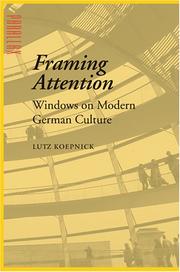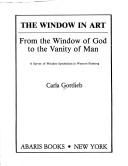| Listing 1 - 10 of 12 | << page >> |
Sort by
|
Book
ISBN: 9781858945545 1858945542 Year: 2011 Publisher: London: Merrell,
Abstract | Keywords | Export | Availability | Bookmark
 Loading...
Loading...Choose an application
- Reference Manager
- EndNote
- RefWorks (Direct export to RefWorks)
Image
Abstract | Keywords | Export | Availability | Bookmark
 Loading...
Loading...Choose an application
- Reference Manager
- EndNote
- RefWorks (Direct export to RefWorks)
Book
Year: 1976 Publisher: Recklinghausen Städtische Kunsthalle
Abstract | Keywords | Export | Availability | Bookmark
 Loading...
Loading...Choose an application
- Reference Manager
- EndNote
- RefWorks (Direct export to RefWorks)
Book
ISBN: 3458191046 9783458191049 Year: 1988 Publisher: Frankfurt am Main Insel Verlag
Abstract | Keywords | Export | Availability | Bookmark
 Loading...
Loading...Choose an application
- Reference Manager
- EndNote
- RefWorks (Direct export to RefWorks)
Book
ISBN: 9783496014096 Year: 2010 Publisher: Berlin Dietrich Reimer Verlag
Abstract | Keywords | Export | Availability | Bookmark
 Loading...
Loading...Choose an application
- Reference Manager
- EndNote
- RefWorks (Direct export to RefWorks)
Windows in art. --- Windows in literature. --- Windows in art --- Windows in literature
Book
ISBN: 2848678828 2848676612 9782848676616 Year: 2019 Publisher: Besançon Presses universitaires de Franche-Comté
Abstract | Keywords | Export | Availability | Bookmark
 Loading...
Loading...Choose an application
- Reference Manager
- EndNote
- RefWorks (Direct export to RefWorks)
Objet transitionnel à deux sens, selon H. Lefebvre, la fenêtre laisse passer la lumière et l’air de l’extérieur tout en constituant un point d’observation du monde du dehors. La fenêtre revêt donc de multiples fonctions et matérialise également différentes symboliques, entre autres celles de l’intérieur et de l’extérieur, du public et du privé, de l’ouvert et du fermé. En tant que cadre, elle a exercé une influence majeure à la perception du paysage et, par extension, à la peinture. L’ouvrage réunit des études qui envisagent la fenêtre dans la littérature et les arts (peinture, photographie, théâtre, cinéma, architecture) par des approches esthétiques, sémiotiques, historiques et narratives.
Art --- art --- littérature --- architecture --- fenêtre --- cinéma --- Windows in art --- Windows in literature --- Literature --- History of civilization --- aesthetics --- theme --- windows
Book
ISBN: 3849813398 3849813177 Year: 2019 Publisher: Bielefeld, Germany : Aisthesis Verlag,
Abstract | Keywords | Export | Availability | Bookmark
 Loading...
Loading...Choose an application
- Reference Manager
- EndNote
- RefWorks (Direct export to RefWorks)
Long description: Betreten, Durchschreiten, Verlassen, Auf- und Absteigen, An- und Durchblicken: Architekturelemente wie das Fenster, der Korridor oder die Treppe stehen paradigmatisch für die Aktivierung des Raums in der Bewegung von Blicken und Körpern. Der vorliegende Sammelband widmet sich literarischen und (architektur-)theoretischen Texten, die eine besondere Sensibilität für solche Raum-Operationen haben. Damit leistet der Band einen Beitrag zum spatial turn, im Zuge dessen die Kulturwissenschaften der letzten zwei Jahrzehnte Räumlichkeit zu ihrem ureigenen Gegenstand machten. Anhand von Autoren wie Georges Perec, Virginia Wolf oder Heinrich Böll, von Architekten wie Le Corbusier oder Bernard Tschumi sowie von Theoretikern wie Jurij Lotman oder Jacques Derrida wird augenscheinlich, dass Raum keine abstrakte Kategorie ist, sondern nur über seine Verwendung in ästhetisch-historischen Kontexten verstanden werden kann. Fenster, Treppe und Korridor werden so als Wahrnehmungsdispositive verständlich, die Kulturgeschichte räumlich fassen, fassbar machen und letztlich selbst Geschichte(n) schreiben. Ohne Anspruch auf Vollständigkeit oder Abgeschlossenheit bietet der Band einen Einblick in aktuelle Forschungsdebatten um einen erweiterten, kultur- und literaturwissenschaftlichen Architektur- und Raumbegriff.
Windows in literature --- Windows in art --- Stairs in art --- Architecture in art --- Architecture in literature --- Staircases in literature

ISBN: 1435692098 0801891892 9781435692091 9780801891892 0801884896 9780801884894 0801884896 9780801884894 Year: 2007 Publisher: Baltimore Johns Hopkins University Press
Abstract | Keywords | Export | Availability | Bookmark
 Loading...
Loading...Choose an application
- Reference Manager
- EndNote
- RefWorks (Direct export to RefWorks)
"In Framing Attention, Lutz Koepnick explores different concepts of the window - in both a literal and a figurative sense - as manifested in various visual forms in German culture from the nineteenth century to the present. He offers a new interpretation of how evolving ways of seeing have characterized and defined modernity." "Koepnick examines the role and representation of window frames in modern German culture - in painting, photography, architecture, and literature, on the stage and in public transportation systems, on the film screen and on television. He presents such frames as interfaces that negotiate competing visions of past and present, body and community, attentiveness and distraction. From Adolph Menzel's window paintings of the 1840s to Nam June Paik's experiments with television screens, from Richard Wagner's retooling of the proscenium stage to Adolf Hitler's use of a window as a means of political self-promotion, Framing Attention offers a theoretically incisive understanding of how windows shape and reframe the way we see the world around us and our place within it."--Jacket
Arts and society --- Arts, German --- Windows in art. --- Arts --- Arts and sociology --- Society and the arts --- Sociology and the arts --- History --- Social aspects
Book
ISBN: 9780300169775 9781588394132 0300169779 Year: 2011 Publisher: New York: New Haven: Metropolitan museum of art, Yale University press,
Abstract | Keywords | Export | Availability | Bookmark
 Loading...
Loading...Choose an application
- Reference Manager
- EndNote
- RefWorks (Direct export to RefWorks)
During the first half of the 19th century, the open window emerged as a consistent motif in German, Danish, French, and Russian painting and drawing. "Rooms with a View" is the first book to explore this intriguing theme in European art, with its Romantic intimations of unfulfilled longing and its associated qualities of poetry, luminosity, and interiority. Artists depicted this intangible mood with images of contemplative figures in hushed, sparsely furnished rooms; painters diligently at work in their studios; simple, serene displays of light entering a chamber; and windows as the focal point of views in their own right. "Rooms with a View" features forty oils and thirty works on paper by both well-known and largely undiscovered artists, including Caspar David Friedrich, Carl Gustav Carus, Georg Friedrich Kersting, Adolph Menzel, Christoffer Wilhelm Eckersberg, Martinus Rorbye, Jean Alaux, Leon Cogniet, and Fyodor Petrovich Tolstoy.
Painting --- anno 1800-1899 --- raam --- open raam --- vergezichten --- ateliers --- stadsgezichten --- landschappen --- Friedrich, Caspar David --- Menzel, Adolph Friedrich Erdmann --- 19de eeuw --- Windows in art --- Art, European --- atelier --- Windows in art - Exhibitions. --- Art, European - 19th century - Exhibitions. --- raam. --- open raam. --- vergezichten. --- atelier. --- stadsgezichten. --- landschappen. --- Friedrich, Caspar David. --- Menzel, Adolph Friedrich Erdmann. --- 19de eeuw.

ISBN: 0913870404 Year: 1981 Publisher: New York, N.Y. Abaris
Abstract | Keywords | Export | Availability | Bookmark
 Loading...
Loading...Choose an application
- Reference Manager
- EndNote
- RefWorks (Direct export to RefWorks)
Christian art and symbolism. --- Windows in art --- Windows --- Art, Christian --- Art, Ecclesiastical --- Arts in the church --- Christian symbolism --- Ecclesiastical art --- Symbolism and Christian art --- Religious art --- Symbolism --- Symbolism in art --- Church decoration and ornament --- Religious aspects --- Iconography --- Painting --- Europe --- Christian art and symbolism
| Listing 1 - 10 of 12 | << page >> |
Sort by
|

 Search
Search Feedback
Feedback About UniCat
About UniCat  Help
Help News
News